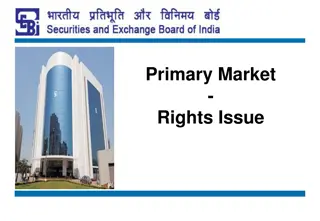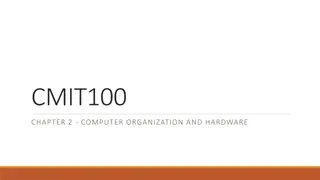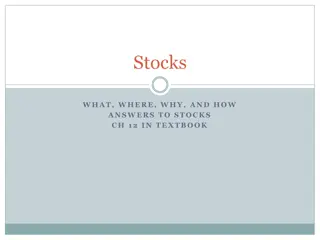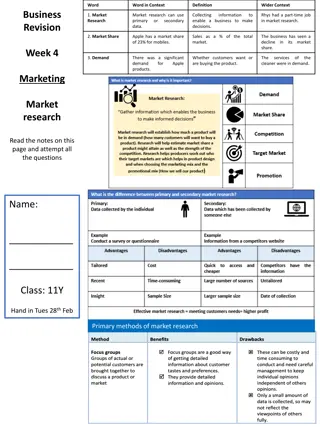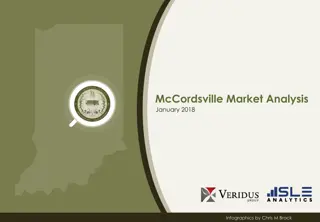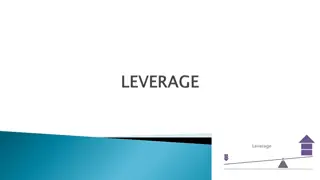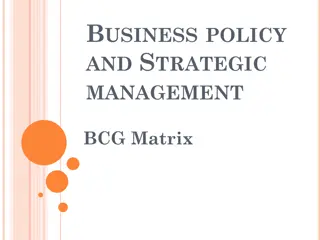Understanding IPOs and the Primary Market
Explore the world of Initial Public Offerings (IPOs) in the primary market, covering topics such as application processes, shareholder rights, price discovery, and more. Learn about the objectives of the primary market, types of issuers and issues, utilization of funds, and the difference between primary and secondary markets.
Download Presentation

Please find below an Image/Link to download the presentation.
The content on the website is provided AS IS for your information and personal use only. It may not be sold, licensed, or shared on other websites without obtaining consent from the author. Download presentation by click this link. If you encounter any issues during the download, it is possible that the publisher has removed the file from their server.
E N D
Presentation Transcript
Primary Market - Initial Public Offerings (IPOs)
Disclaimer Disclaimer Information contained in this presentation is as on September 30, 2022. The information contained in this presentation is only for Educational and Awareness Purposes related to securities market . This presentation is only for Educational and Investor Awareness Programs and shall not be used for any legal interpretations. SEBI or Stock Exchanges or Depositories shall not be responsible for any damage or loss to any one of any manner from use of this material. Suggestions or feedbacks, if any, may please be sent by mail to visitsebi@sebi.gov.in. 2
Flow of Presentation Introduction to Primary Market. IPO Initial Public Offering: How to apply for Public Issues? Rights & Responsibilities of A Shareholder. Pre Application Analysis. Information in Offer Document. Price Discovery of Shares: Fixed Price and Book Building Mechanism. Allotment Intimation, Transfer of Shares and Debit/Credit of Funds. Sample of Registrar and Transfer Agent (RTA) details on Company Website. Checking Allotment Status and Grievance Mechanism. Advice to Investors. 3
Introduction to Primary Market New issues market where Company/ institutions raise funds or capital from public by issuing new securities. Objective: To raise capital. Two major types of issuers of securities: - - Corporate Entities (Companies) Government (Central and State) Major types of Issues in Primary Market: - - - - Public Issue Preferential Issue Rights Issue Bonus Issue 4
Introduction to Primary Market New Projects Objects of Issue Expansion of existing projects/ modernization Up-gradation Diversification Objects of the issue and intended utilization of funds Given by issuers in the Offer Document 5
Introduction to Primary Market New Issues market (Primary market) Money Market Financial markets Securities Market Capital Market Secondary Markets Other forms of lending and borrowing 6
Primary v/s Secondary Market : Key Differentiation Features Primary Market Secondary Market Securities issued first time to the public. Trading of already issued and listed securities. Definition New Issue Market. Post Issue Market. Also called as By consultation Bankers. Merchant Bankers, Bankers/ Lead Managers, RTAs. - Raise capital for expansion, diversification, etc. - To seek listing of securities. Issuer Company with Merchant in Supply and Demand Forces of Market. Price Determination Stock Brokers and DPs. Key Intermediaries Purpose - - - Trading of securities. Providing liquidity to investors. Raising further expansion. capital for 7
Modes of Public issues Issues Private Placements Public Issues Rights Issues Bonus Issues Qualified Institutional Placement Preferential Issue IPO FPO Fresh Issues Offer for sale Fresh Issues Offer for sale 8
Modes of Capital Issuances Initial Public Offering. Done by unlisted company. Fresh issue of securities/ offers its existing securities for sale/ Combination of both. Securities issued for the first time to the public. Paves way for listing and trading of the issuer s securities in the Stock Exchange(s). IPO Further Public Offer / Follow-on Offer. Done by already listed company. Fresh issue of securities / Offer for sale of securities to public . FPO Done by already listed company. Issue of securities to its existing shareholders (as on a Record date). Record Date is fixed by the issuer. The rights offered in a particular ratio to the number of securities held by existing shareholders as on the record date. Rights Issue 9
Modes of Capital Issuances Done by already listed company. Issue of shares to existing shareholders (as on a record date). Existing shareholders need not make any payment for Bonus shares. Shares are issued out of the company s free reserve or share premium account. Issued in a particular ratio to the number of securities held on record date. Bonus Issue Done by already listed company. Issue of shares / convertible securities (like warrants) to a select group of persons. Subject to prescribed norms such as minimum pricing, minimum public shareholding and lock-in. Preferential Issue Qualified Institutional Placement. Done by already listed company. Issue of shares / convertible securities (like warrants) to Qualified Institutional Buyers (QIBs). Subject to prescribed norms such as minimum pricing and minimum public shareholding. QIP 10
IPO - Initial Public Offering Process of a company to be publicly listed and traded company. IPO: Fresh issue of shares / Offer for Sale of shares by existing investors/ Combination of both. Process of IPO is as follows: Issuer files an Offer Document in prescribed format with Securities and Exchange Board of India (SEBI), Stock Exchanges and the Registrar of Companies (ROC) for listing on the stock exchanges Issuer receives observations from regulatory authorities After complying with all observations, issuer can open the offer inviting general public to invest in the IPO subject to stipulated timelines Post successful completion of the Offer the shares of the company are traded on the stock exchange(s) where the shares are listed. 11
How to apply in Public Issue? ONLINE MODE - - - Application Supported by Blocked Amount. Facility provided by Self Certified Syndicate Banks (SCSBs) Full Bid Amount blocked in the bank account of the bidder. ASBA - For a) Retail Individual Investors. b) Shareholders bidding in Shareholders Reservation Portion up to Rs.5,00,000/-. UPI in ASBA - - Application via UPI facility of Sponsor Bank. Applying in IPO through 3-in-1 account (demat, trading and bank account). 3-in-1 Account OFFLINE MODE - - To open a Demat Account first. Investors may obtain Application Form from Stock Broker/ Sponsor Bank/ Exchange Website. Form submitted to Stock Broker/ Sponsor Bank. Filled Form - 12
Rights of a Shareholder Part-owner of the company, in proportion to their holding in the company. Right to receive corporate benefits like dividend, whenever declared. Right to receive: - Annual Reports - Audited Financial Statements - Notices of General Meetings and other notices - Other information disseminated by company. Right to attend company meetings. Right to contribute in key corporate governance decisions through postal ballot/ e-voting. 13
Rights of a Shareholder (subject to certain limitations/ restrictions) Right to: - - - Ask questions to the board of directors. Place items on the agenda of general meetings. Propose resolutions, etc. Right to participate in matters needing shareholder approval like: - To vote in company proceedings. - To approve mergers & acquisitions, appointment of directors on company board, changing auditors, etc. Right to Inspect company s statutory books and records. Right to Transfer shares by applicable laws. To raise grievances, if any, against the company (using SCORES, etc.). 14
Responsibilities of Shareholder Stay informed! ANNUAL REPORT : - Circulated to all Shareholders (via Post / Email). - Available on website of Company and Stock Exchanges. - NOTICE : for shareholder meetings with details of the agenda. - MD s NOTE : the managing director's note in the annual report to understand how the business is doing. - AUDITOR s NOTE : check if there are any red-flags / adverse findings flagged. INFORMATION ON STOCK EXCHANGE WEBSITE : - Company s structural changes, updates, press release, investor presentations etc. under corporate announcements, which any investor should refer to. 15
Pre-Application Analysis : Broad Contours Product, Plant and Pricing Investors should take a well- informed decision of investing / applying in an IPO / FPO / Rights issue. Sustainability & Growth Scalability and Addressable Market Points to be considered as a part of pre- application analysis (before investing / applying in an IPO/ FPO / Rights application). Business Beyond Numbers Management Quality Don t go by mere rumours / euphoria over returns as what the others feel. Sustainable Margins: Absolute & Relative expected Stakeholders Behavioral Pattern Corporate Governance Invest based on one own risk appetite investment parameters. Corporate Structure and Business Succession 16
Information in Offer Document Sample Snapshots 17
Information in Offer Document Table of Contents TIP: Before investing in any prospective offering of shares, always go through such offer documents, available on websites of SEBI and Merchant Bankers. 18
Information in Offer Document About the Company: Financials Management and Promoter Section - Business: Company s business model, strategies and manufactured products/ process/ services. - History and Corporate Matters: Material events taken place in company s history and other corporate matters - Company's income statement and balance sheet. - Understand company s past performance and growth potential. - Background and the experience of the company s management team. Litigation and Dispute matters Risk Factors - Litigations in which the issuer company, subsidiary(ies), group company(ies), promoter(s) are involved. - Risks associated with the business, industry etc. 19
Information in Offer Document Objects of the Issue Capital Structure - Basic purpose of the company for going public and / or raising funds. - Capital formation of the company, - Existing shareholders and their percentage shareholdings etc. - Informs how the funds will be utilized. Managements discussions and Analysis of financial conditions and results of operations - Information related to the strength of the company's business plan, recent developments, performance etc. - Performance analysis with qualitative and quantitative measures. Basis for Issue Price - Helps understand the basis for pricing - Comparison with other listed entities in the same / similar segment. 20
Other key Sources of Information for Analysis Minutes of the meetings of the Board / Shareholders of the issuer company ROC Filings made by the Company since Inception; Research Reports Collaboration Agreements/Sharehold ers Agreements Industry Reports; Credit Ratings; Third Party Techno Economic Viability Reports etc. Reports/certification on project; 21
Price Discovery of Shares in a Public Offering Mode of Price Discovery Type of Issue Fixed Price issue IPO Book Building Issue More common mode of IPO 22
Price Discovery of Shares in a Public Offering - Fixed price issue Fixed price issue: Price at which the securities are offered and will be allocated is fixed by Company along with Merchant banker Fixed price is printed in the Offer Document, usually along with reasoning behind the price at which shares are offered. Demand for the securities offered is known only after the closure of the issue. 50% of the shares offered are reserved for applications below Rs. 2 lakh and the balance for higher amount applications. 23
Price Discovery of Shares in a Public Offering - Fixed price issue Illustration of Fixed Price Issue: First page of the prospectus contains: - Number of shares to be issued - Price of issuance Price is already fixed prior to the IPO. No price discovery mechanism is used. All application for shares have to be made at the price mentioned else they are considered as invalid bids. 24
Price Discovery of Shares in a Public Offering Book Built Issue: Floor Price: Lower end of Price Band Cap Price: Higher end of Price Band Eg: Rs.100/- to Rs.120/- Company may offer a maximum of 20% price band in which one can bid for shares. Price Band is independent of Face Value (FV) of shares. Investors must specify: - Number of shares they want to buy. - Price they are willing to pay per share (within the price band). Issuance Price discovered on the basis of demand at various price levels (within Price band) 25
Price Discovery of Shares in a Public Offering Stages in Book Building: Company who is planning an IPO appoints the Lead Merchant banker(s) as Book Runner . Investors give their bids for these shares to Syndicate Members . Bids have to be entered within the specified price band. Investor can revise a bid before the book closes. Syndicate members input the orders into an Electronic Book through process called Bidding . Book normally remains open for a period of 5 days. On closure of the book building period, the Book Runner evaluates the bids on the basis of the demand at various price levels. Book runners and the issuing Company decide the final price at which the securities shall be issued. Finally allocation of securities is made to the successful bidders. Money gets unblocked in bank accounts of rest of the bidders. 26
Price Discovery of Shares in a Public Offering Illustration of Book Building issue: Price band = Rs. 20.00 (Floor Price) to Rs. 24.00 (Cap Price) per share Total available shares (issue size) = 3,000 shares. Company received five bids from bidders as mentioned below: Bid Quantity 500 1,000 1,500 2,000 2,500 Bid Price (Rs.) 24 23 22 21 20 Cumulative Bid Quantity 500 1,500 3,000 5,000 7,500 Subscription 16.67% 50.00% 100.00% 166.67% 250.00% Price discovery is a function of demand at various prices. Highest price at which the issuer is able to issue the entire size of 3000 shares is the price at which the book cuts off = Rs. 22.00. The issuer, in consultation with the Book Running Lead Manager will finalize the issue price at or below such cut-off price, i.e., at or below Rs.22.00. Valid Bids: All bids at or above this issue price and cut-off bids (allowed for retail investors only) and they are considered for allocation in the respective categories. 27
Book Building v/s. Fixed Price Issue Features Fixed Price Process Book Building Process - Price at which securities are offered /allotted is known in advance to the Investor. - Price at which securities will be offered/allotted is not known in advance to the investor. Pricing - An indicative price range is known. - Price is fixed in this process. - Only the Retail Individual Bidders are permitted to bid at a cut off price which makes the application valid irrespective of any discovered issue price with in the price band. Cut off price - Known only after the closure of the Issue. - Demand can be known everyday as the book is built. Demand 28
Process Flow : Fixed Price Method Receipt of In- Principle Approval from Stock Exchange and observations from SEBI Issuer Appoints SEBI Registered Intermediary except Syndicate Member Lead Manager files Draft Prospectus with SEBI/Stock Exchange Due Diligence Applicant submits application form to Intermediary for uploading on Stock Exchanges platform Determination of Issue period & Issue Price Filing of Prospectus with ROC Issue Opens Completion of Post Issue Compliances Issue Closes 29
Process Flow : Book Building Method Book Running Lead Manager files Draft Red Herring Prospectus with SEBI/Stock Exchange Receipt of In- Principle Approval from Stock Exchange and observations from SEBI Issuer Appoints Merchant Banker, Legal Advisor, RTA, Syndicate Member, Underwriter etc. Due Diligence Applicant/Bidder submits application form to Intermediary for uploading on Stock Exchanges platform Determination of Issue period & price band Filing of Red Herring Prospectus with ROC Issue Opens Completion of Post Issue Compliances Issue Closes 30
Book Building Process : Sample Form Investors may refer this application form filled for applying in the IPO. Only Retail Individual Bidders option to tick at the cutoff price . have the Others need to specify the price (within the price band) at which they wish to apply. Forms available on websites of BSE and NSE 31
Sample Application Form Sample is only for illustrative purpose and may not be exactly same as actual application form 34
ASBA Application via Online Mode Source : https://www.onlinesbi.com/ 35
IPO Application Form via UPI Create UPI ID with any of IPO enabled BHIM UPI apps Enter UPI ID on IPO Application Check notification on your BHIM UPI app and approve Check application details and proceed Enter UPI PIN to approve the mandate block Confirmation of transaction Source : https://www.bhimupi.org.in/ Mobile Number mentioned in IPO application must match with Mobile Number linked to bank Account and UPI ID 36
Illustration for IPO Application Confirmation (From bank / Stock Broker) 37
Allotment Intimation, Transfer of Shares and Debit/Credit of Funds Basis of Allotment : - Finalized by the Company with the Lead Mangers, Registrar to Issue, and Stock Exchanges. - Published and gives details of category wise demand for shares and how shares have been allotted. Intimation of allotment to applicants : - Made through ordinary post / SMS/ Email. - Available on the website of the Registrar to an Issue (RTI) Compensation to Retail Individual Investors in an IPO - Compensation for opportunity loss due to non-allotment of shares if failure is on account of Self Certified Syndicate Banks(SCSBs) - Compensation paid if listing price is more than issue price - Apply for compensation within three months of the listing date 38
Allotment Intimation, Transfer of Shares and Debit/Credit of Funds Issue gets oversubscribed (demand > shares available for subscription) Shares are allotted on proportional basis / lottery system. Registrar prepares and releases the fund transfer instruction for transfer of funds to Public Issue and unblocking of funds wherein bidders have not received allotment. Registrar also gives instructions to NSDL and CDSL for credit of Equity Shares to the successful Bidders as specified in the Offer documents. Date of allotment and date of listing of the shares can be checked in the Offer Document. 39
Illustration for checking details of Allotment and Listing Dates These details can be found in the Section on Offer related information Terms of the offer . 40
Checking Allotment Status and Grievance Mechanism Status of allotment/ refund related to IPO application - informed to investors by SMS/ email/ letter. - May be checked by visiting InvestorServices section on the website of the Registrar and Transfer Agent (RTA) for the Issue on the indicative Allotment Date mentioned in the Offer Document. Issue with regard to Non-allotment of shares / Refund etc. - Contact RTA immediately. 42
Checking Allotment Status and Grievance Mechanism Contact Details of Registrar and Transfer Agent (RTA): - Provided in Offer Document of IPO - Available on SEBI Website at: https://www.sebi.gov.in/sebiweb/other/OtherAction.do?doRecognisedFpi=yes&in tmId=10 Non-Satisfactory Resolution by RTA -> File a complaint against RTA with SEBI on: - SEBI SCORES website/ Mobile App (on Android and iOS platform) 43
Illustration for Allotment Status (Email) 44
Illustration for Allotment Status (Bank / Stock Broker Website) 46
Advice to investors Don t invest with anticipation of making quick profits on listing of shares. Do not deal in shares in Black market / Grey Market Invest in IPOs for the long term. Use your own funds to apply for an IPO. Funds routed through any Third-party is not allowed as valid payment. One person (identified by PAN number) is permitted to make only one application in an IPO. 47
48 Additional Information Additional Information For further information, you may visit the following web-sites and Mobile App: www.sebi.gov.in/ https://investor.sebi.gov.in/ Saa Saa thi thi App App For Grievance Redressal, you may visit following website: www.scores.gov.in/ Or, you may call SEBI at following Toll-free Helpline Numbers from 9:00am to 6:00pm on all days (excluding declared holidays in the state of Maharashtra): 1800 266 7575 1800 22 7575 SEBI : HAR INVESTOR KI TAAQAT Helplines are available in 8 Languages: English, Hindi, Bengali, Gujarati, Marathi, Kannada, Telugu and Tamil 48
Thank You 49





